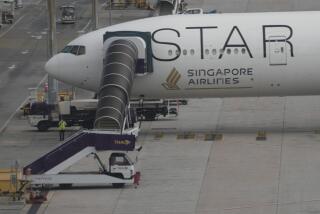No Scientific Way to Determine Safest Seat : Airlines: Because each crash is different, experts still can’t recommend the best place to sit on a plane.
NEW YORK — Bart Simon, seat 4F, didn’t have to hunt for an exit when USAir Flight 405 crashed at La Guardia Airport last month.
“I just stepped outside,” the Cleveland businessman and crash survivor said. “I didn’t even have to duck my head.”
Simon had what flight safety experts consider the best seat on a plane that rips open on takeoff or landing: one next to the gash.
“The probability of escape lies in the crapshoot of where the fuselage breaks open,” said Ira Rimson, a veteran accident investigator. “If it breaks where you’re sitting, you might just walk out.”
But beyond that entirely useless bit of wisdom, the experts have surprisingly little to say that is not common sense about where to sit, when to fly or what other moves passengers can make to boost their chances of surviving a crash.
The experts do deem it wise to pick airports with long runways, nonstop flights and aisle seats near an exit. Pay attention to the attendant’s safety show, they also say, and, if you are in a crash, tuck yourself into a ball, thinking “small,” and then stay low on your rush for the exit, having memorized the route.
But the microscopic probing that produces exquisitely detailed explanations of each plane crash has yet to translate into such down-to-earth advice as whether to book seats in the front or back of an aircraft.
“There is no one safe place to sit,” said Matt McCormick, chief of the survival factors division of the National Transportation Safety Board, which investigates all airplane accidents.
The problem is that each crash is unique.
Take USAir Flight 405: Seventeen of the 25 people in the front half of the plane made it out alive, for a survival rate of 68%. Four of the 21 in the back half lived, a survival rate of 19%. So fortunate were those in the front end that all four first-class passengers and everyone in the next two rows came out nearly unscathed.
Compare that to a 1989 article in New York magazine that analyzed 11 accidents to conclude that seats in the rear third of planes were 38% safer than those in the front third.
A more recent study conducted by Conde Nast Traveler magazine skirted the front-back question but reported an analysis of the survival rates in various types of aircraft that had been involved in fatal crashes.
Leading at 79% was the BAC 1-11, followed by the DC-10 at 78% and the 737 at 68%. The magazine rated the worst as the 707, at 37%; the 727, at 38%, and the DC-9, at 44%.
Most experts scoff at these studies, arguing that there have been too few crashes to make any statistical manipulation mathematically valid. To see just how manipulative data can be, consider this recent report from the research laboratories of General Motors. Titled, “Is it Safer to Fly or Drive?,” the 1989 study seeks to debunk the “conventional wisdom” that it is safer to fly than to drive.
“Drivers with the age distribution of airline passengers are less likely to be killed on the trip to the airport than on the flight,” the report asserts.
But you have to read the fine print. The study based this rather startling conclusion on data specifying 40-year-old, belted, alcohol-free drivers of cars 700 pounds heavier than average and driving only on 600 miles of rural interstate, compared to the same distance flying.
Knowing how to use the equipment that is available will also increase your survivability. Flight-safety advocates such as the International Society of Air Safety Investigators are working to force airports to equip lounges with masks, life vests and other safety equipment that passengers can check out while awaiting their flights.
In the meantime, investigator Rimson said that he and his wife entertain themselves on long flights by asking to try on the life vests. “By the time we got into one, everyone in the cabin wanted to try one on,” Rimson said.
More to Read
Sign up for Essential California
The most important California stories and recommendations in your inbox every morning.
You may occasionally receive promotional content from the Los Angeles Times.










